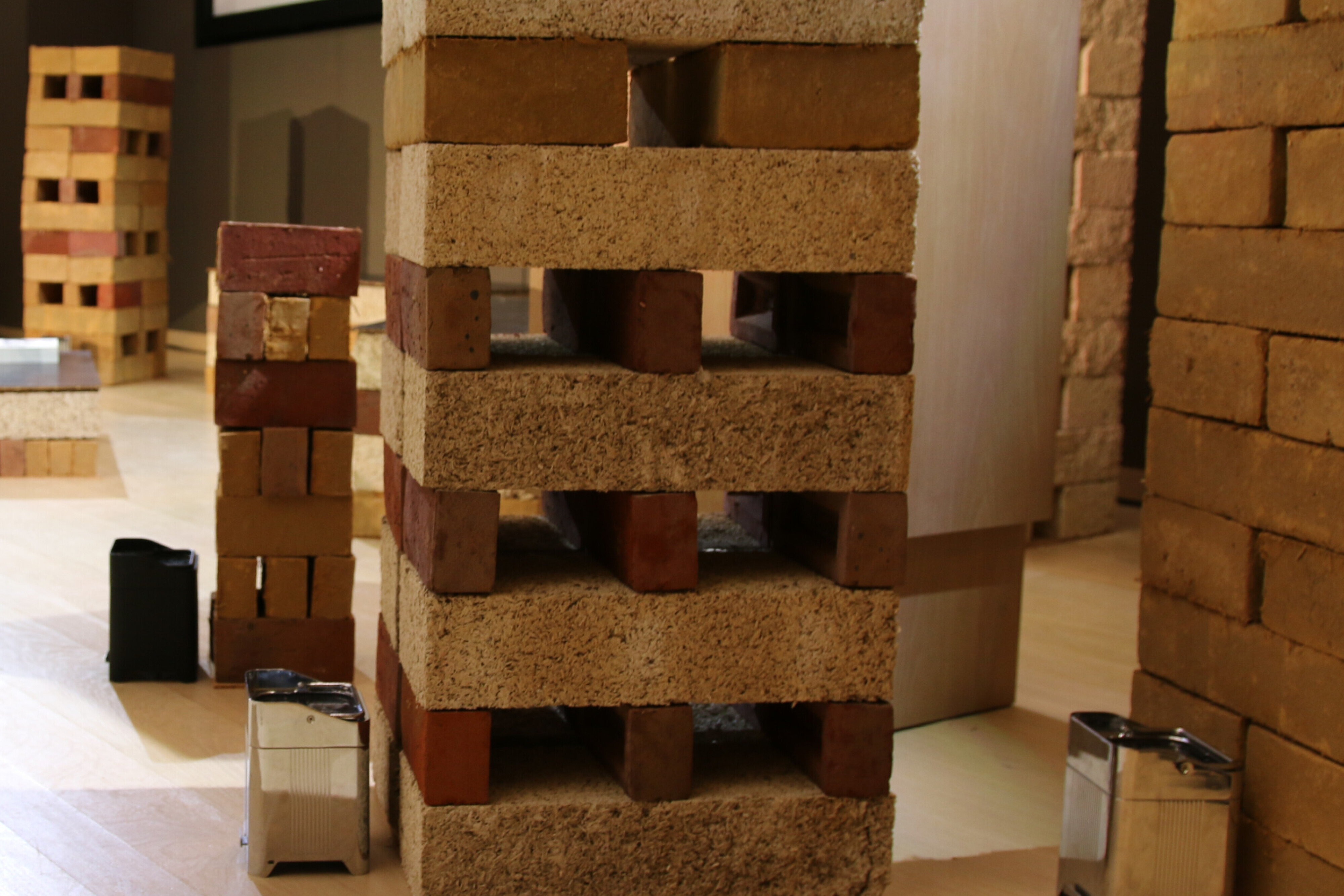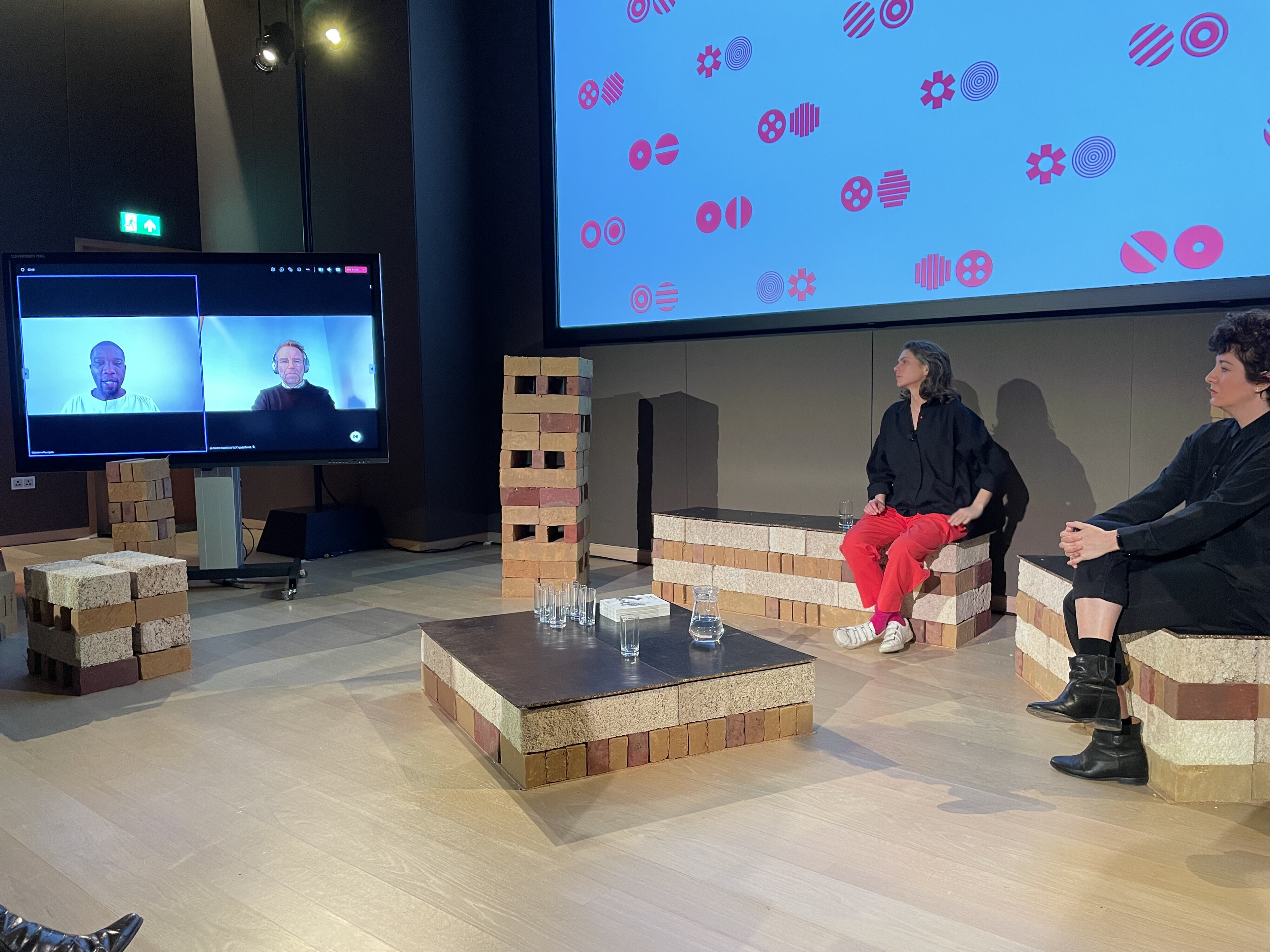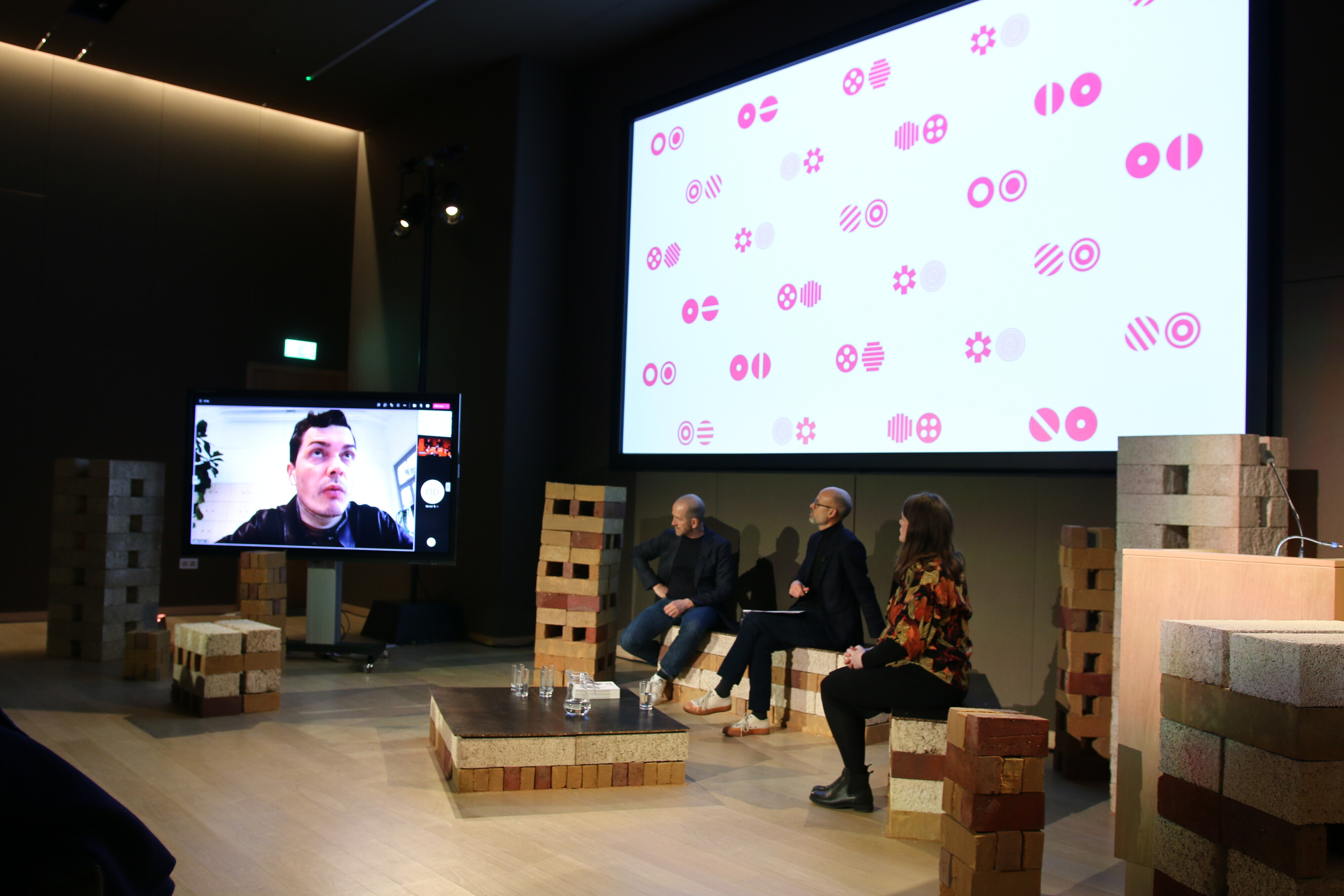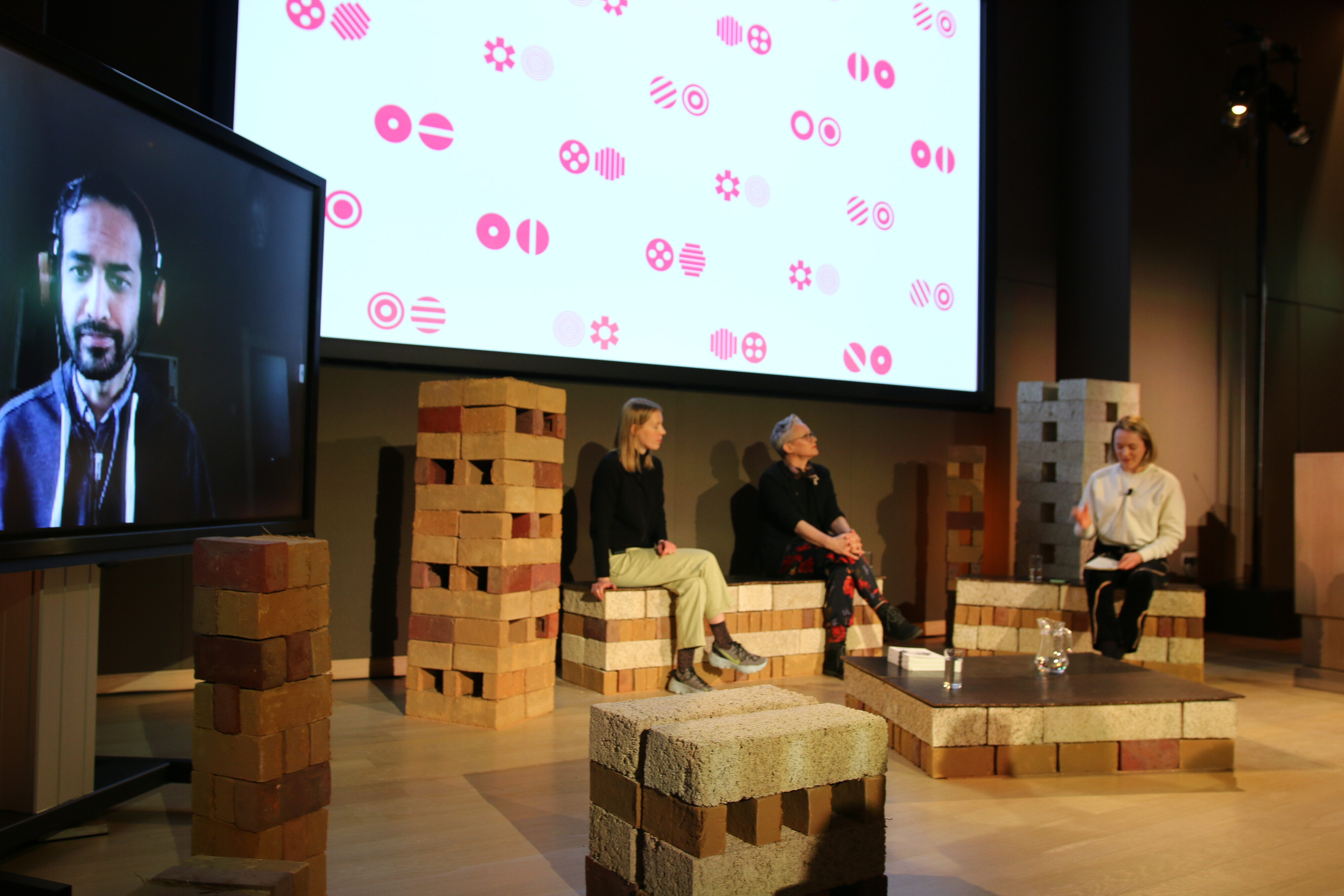“The first question any design researcher with an innovative idea encounters is, how do you scale that up?”
This was one of the central questions that our team had been pondering in the lead up to the Questions of Scale symposium, and which our director Justin McGuirk put to the audience at the Design Museum on 10th February 2022.
“Is scale always desirable?” continued McGuirk, considering the ecological damage often inherent in the materials, products and processes that have reached planetary scales. The day unfolded across three discussions with a worldwide selection of panellists (joining both in person and remotely) who would tackle questions of scale from different angles. Economic scales: how should new, sustainable products grow as businesses without inheriting extractive production methods? Time scales: what outcomes might arise if designers work to non-anthropocentric time scales? And opening the day, a panel on geographic scale: are myriad local approaches better than monopolistic global ones?
Geographic Scale
The work of three practices presented on this panel – Material Cultures, Atelier Luma and Mass Design Group – made the case for a more regionally based approach. Summer Islam of Material Cultures, a London-based non-profit design and research practice, presented the group's research in East Yorkshire, where the pressures of the climate crisis, the housing crisis and long-term government underinvestment in the region are keenly felt. Thinking through the scale of the material, the building and the landscape, Material Cultures propose a new “bioregional construction economy to support the need for 500,000 homes by 2038”.

This emphasis on the bioregional scale was echoed by Jan Boelen, director of Atelier Luma, who aims to connect his “dirty and undisciplined laboratory” with the people, natural parks and heritage around Arles, southern France, where the lab is based. Designers and researchers based at the lab work with locally sourced algae and sunflowers, to produce new building and product materials. Yet these innovations are not being produced with mass production or consumption in mind. Rather the approach of Atelier Luma is to encourage design work with materials found in the vicinity of their labs. “We’re exporting the ideas to other regions, not the products,” explained Boelen, who was vocally resistant to one-size-fits-all approaches in design, asserting that “monoculture is killing the connections between things.”
These were also resonant perspectives for Christian Benimana, a director of Mass Design Group, the international architecture practice who were recently honoured with the 2022 AIA Architecture Firm Award. Speaking from Kigali, Rwanda, Benimana highlighted the acute need for increasing infrastructural capacity across the African continent, which faces significant population increases over the next 40-50 years. Their approach to scale, however, is not to address these issues from a continental scale, but to take systemic design approaches to their projects. “What are the systems outside of a project we can influence for the better?” Benimana asks. Their work on the Butaro District Hospital campus, for example, takes a holistic approach to health whereby residential facilities and landscape design are influencing healing as much as the doctors employed there.

In this sense, the architect acts as what Summer Islam describes as an “interlocutor”, an intermediary “between different industries, farmers, foresters, policymakers – to create systems that work better in the future.” This systemic approach is, however, always applied on a local level. Responding to a question about the tension between local vs planetary or globalised solutions, Benimana argued “I would worry less about the global problems if we are able to solve the local problem because what we call global problems are an amalgamation of the problems caused in local communities.” For Jan Boelen, addressing local problems to answer global ones is a question of time and redesigning our relationship with time. “In all these projects, there is a new relation with time coming up,” he observed, leading us neatly onto the second panel of the day.
Time Scale
“10,000 years is no time, a tiny amount of time in the life of our planet,” pointed out Helen Gordon as she opened the second discussion of the day. Gordon is the author of the book Notes from Deep Time, an exploration of geological time, which provides temporal perspective for thinking through different time scales in design. “How can we engage with things happening at such a large scale?” she asked, referencing the climate crisis. “By becoming more time literate, more deep-time literate.”
Joining Gordon on the panel from his studio in Milan, Simone Farresin laid out how Formafantasma – the design studio Farresin runs with Andrea Trimarchi – think and teach through different time scales as part of their Geo-Design master's course at Design Academy Eindhoven. Designing in the short term is “intervening in the status quo,” he explains. “Not necessarily with a visionary solution, but something which can simply improve what we already see”. For example, designing an electronic product to be repairable and recyclable to counter the global growth of e-waste. A medium-term approach is a more strategic one: rethinking the distribution of products and the infrastructure around them. Meanwhile a long-term solution would be more visionary. “It would have the aim to completely rethink, not the way we design things, but the way we conceive of economic models,” Farresin explained.
The buildings of architects Waugh Thistleton – trailblazers in timber construction in the UK, whose director Andrew Waugh rounded off the session – might be seen to intervene in the short term, in response to the pressing time concerns of this moment. “We have eight years to reduce the amount of concrete we use by 50%,” Waugh said, before presenting two recent projects by the practice. Murray Grove is a nine-storey residential building in East London with a cross-laminated timber (CLT) structure assembled in 27 days, while Dalston Works is a 121-unit residential complex, also in East London, was the largest CLT building in the world when it was completed in 2017and was constructed in five months.

This speed of construction is clearly appealing, although the sourcing of timber presents a clear temporal tension. The move to widespread timber construction must be coupled with ecologically sensitive and restorative processes of harvesting and growing wood in rural ecosystems. In the session Q&A, Simone Farresin was quick to point out the difference between a plantation and a forest – the former being a site for producing timber without the biodiversity required for healthy forest ecosystems – complicating the narrative that more tree cover in Europe is necessarily indicative of environmental progress.
Economic Scale
Questions of sustainable supply and material extraction also emerged in the final session of the day which centred on economic scales and was chaired by Hettie O'Brien of the Guardian, asking, “What might it mean to scale up an alternative in the face of an economy that isn't always conducive to solving the climate crisis?”. Karlijn Sibbel of Notpla opened the session, presenting the company's packaging products made from seaweed and plants that are designed to disappear. Nirav Patel, CEO of repairable laptop start-up Framework, laid out his company’s plans to tackle the “mindset of disposability” that dominates contemporary consumer markets. Closing the day, Professor Becky Earley of the Centre for Circular Design presented a number of projects addressing material waste in the fashion industry, including Herewear, an EU-funded initiative for locally produced circular textiles and clothing made from bio-based resources, also including seaweed.
Each speaker highlighted their aims to move from designing specific products to the infrastructure around those products. Beyond designing boxes and other containers for storing food, for example, Notpla are working with paper suppliers and packaging companies to increase the use of bio-based materials in place of plastics – those less visible parts of the industry that don't come under consumer scrutiny at supermarkets. Similarly, as Patel explained, the increasing popularity of the modular Framework laptop has given rise to a secondary market of makers and repairers who keep the laptops in use for longer. “We want to enable them to use their product for as long as they'd like to, instead of only until some part of it wears out,” he explained, via video call from the west coast of the US. “The goal for us is to maximise that length of time and maximise that number of people instead of maximising the amount of new material that goes out there.”

Professor Earley's research with H&M, meanwhile, has found that tiny interventions in manufacturing processes can have a vast impact when dealing at the scale of a global fashion and economic superpower. “By improving a black stretch denim pair of jeans at H&M which sold in millions of units every year, making incremental changes made a huge carbon footprint saving,” she explained.
Observations
Our questions and takeaways on the day
Scale isn’t just a question of volume: it is also the geographical reach of new ideas.
Can we achieve scale in a way that challenges the damaging models of the monoculture and the monopoly?
We are so used to working to the principles of “human-centred design” but now need to achieve scale while designing for and with living systems.
How do we think to longer timeframes when we are constantly reminded that we have less than a decade to limit global warming to 1.5 degrees Celsius?
How do you build an economic case for more expensive organic materials that are competing with “artificially cheap” materials such as plastic that have long been subsidised?
So many business models rely on short product life. Can we build viable business models around longevity?
Who drives change? Is it consumer behaviour? Businesses? Policymakers? Or designers?
